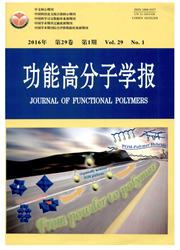

 中文摘要:
中文摘要:
以水溶性高分子聚乙烯吡咯烷酮(PVP)为空间稳定剂,在经十八烷基三氯硅烷(OTS)改性的玻璃表面进行原位聚合,沉积得到导电聚苯胺(PANI)薄膜。采用表面界面张力仪、扫描电镜(SEM)、紫外可见光谱(UV-Vis)、红外光谱(FT-IR)、四探针电导率测试仪及光学显微镜对不同基体表面的接触角、PANI膜的形貌、厚度、结构、导电性及其在亲/憎水表面选择性沉积性能进行测定。结果表明:OTS对玻璃表面的改性促进了聚苯胺的沉积且提高了薄膜厚度,薄膜饱和厚度达到200nm;缩短了溶液中苯胺分散聚合的诱导期,反应速率增大;与未改性玻璃表面沉积的薄膜相比,改性的玻璃表面得到的聚苯胺薄膜更加细密均匀,聚苯胺颗粒尺寸小,堆积紧密;薄膜的电导率达到7.5×10^-3S/cm;OTS改性对基体表面的薄膜生长和溶液中的苯胺聚合具有催化作用。
 英文摘要:
英文摘要:
The conductive polyaniline (PANI) films were in-situ deposited on the octadecyltrichlo- rosilane (OTS) modified glass plates. In this process, a water-soluble polyvinyl-pyrrolidone (PVP) was employed as the steric stabilizer. The contact angle, morphology, thickness, chemical structure, and conductivity of the PANI films were characterized with surface tension instrument, SEM, UV-Vis spectroscopy, FT-IR, and fourprobe testing meter, respectively. The results suggest that the OTS coating on the glass substrate not only significantly promotes the deposition of PANI onto the substrate but also increases the film thickness with the saturated film thickness up to 200 nm. Moreover, the coating shortens the induction period of the polymerization of PANI and thus acceler- ates the polymerization rate. In comparison with the pristine glass substrate, the PANI films on the OTS-coated glass are more compact and uniform with a smaller PANI-particle size. The conductivity of PANI film measured OTS coating may catalyze polymerization of PANI in to be 7.5×10^-3S/cm. The further control experiment indicates that the deposition process of PANI on to the glass substrate as well as the solution.
 同期刊论文项目
同期刊论文项目
 同项目期刊论文
同项目期刊论文
 期刊信息
期刊信息
